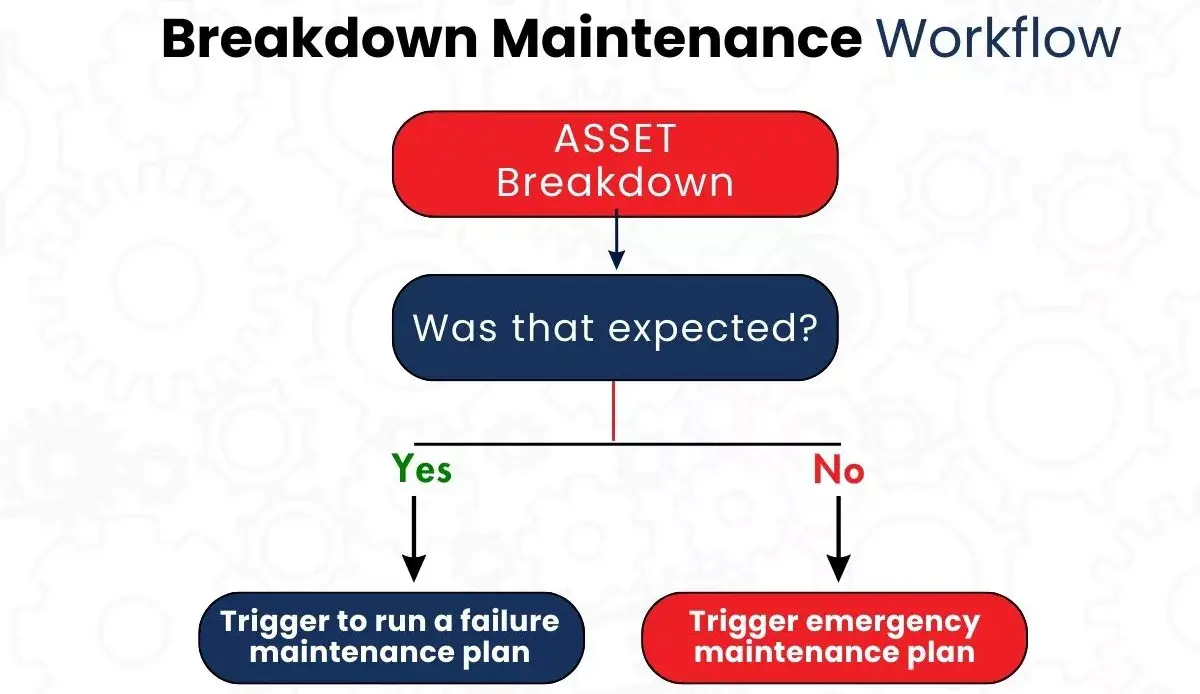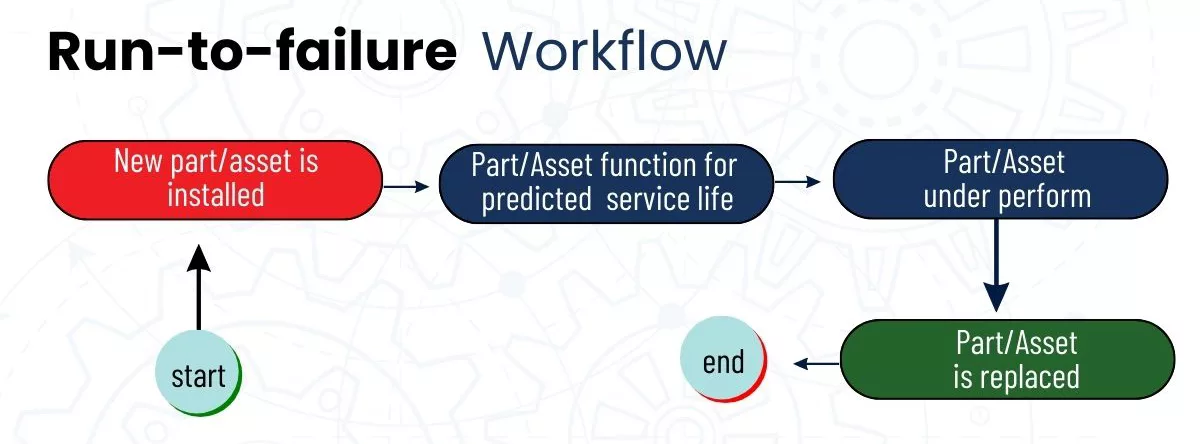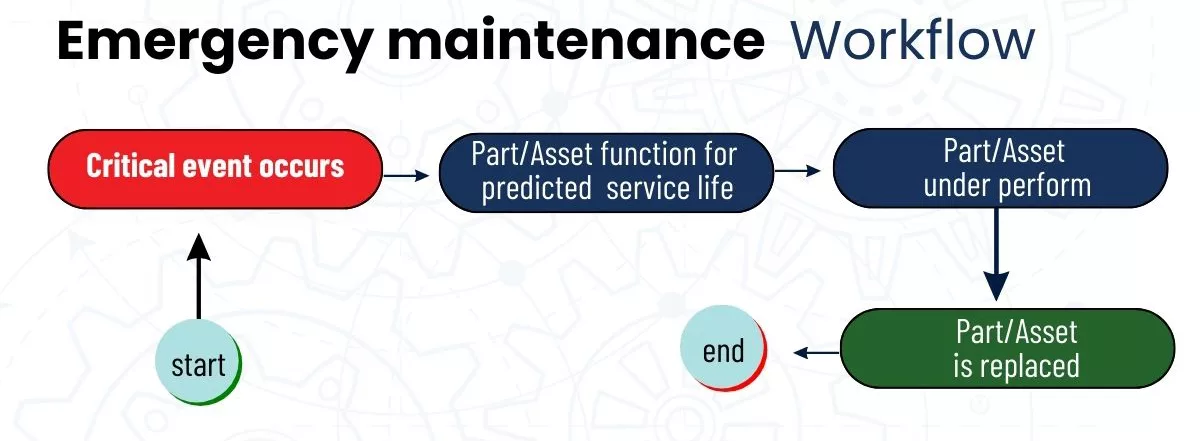What is breakdown maintenance?
It is a type of maintenance carried out on equipment that is out of order. This type of maintenance is unplanned and performed on malfunctioning equipment. A few assets don’t need preventive maintenance because their failure is manageable. These assets are less valuable, and the company doesn’t want to spend extra on them, whereas high-value assets are constantly under preventive maintenance to safeguard them from sudden failure.
Although breakdown maintenance is conducted after equipment fails to function, it can be performed strategically.

Category of breakdown maintenance
To effectively manage a breakdown program, it can be classified into two types.
1. Run-to-failure maintenance
In run-to-failure maintenance, the organization is ready to handle a machine that will stop functioning soon. The assets under this maintenance are easy to replace and won’t disturb the operational system.
The cost of repairing these assets under run-to-failure maintenance is less than the preventive maintenance costs. Inexpensive or unimportant parts and machinery can be repaired under run-to-failure maintenance.

2. Emergency maintenance
Emergency maintenance is needed when an essential piece of equipment goes out of order unexpectedly. The organization must repair it promptly before the system completely halts.
However, this type of sudden breakdown is expensive and causes a lot of safety hazards.

How to effectively manage equipment failures
Unexpected breakdowns are costly and bring many headaches to the company. You need to sort out the problem as early as possible.
Set priority
Each day presents daunting workloads, leaving you unsure where to begin. You need to prioritize tasks. The maintenance team must identify the machinery requiring immediate attention, focusing on fixing the most urgent assets to prevent disruptions to production.
Accelerate maintenance work
Accelerate breakdown maintenance work to minimize downtime and boost productivity. You can reduce the impact on operations and potential losses by identifying and addressing equipment failures.
Implementing specific processes, such as rapid diagnosis, streamlined repair procedures, and prioritized task allocation, ensures timely resolution of issues and flawless continuation of production activities.
Outsource breakdown maintenance
When you outsource maintenance, you can access specialized expertise and resources without in-house investment. By working with external maintenance service providers, you can streamline operations and focus on core activities.
Outsourcing can also render flexibility in scaling maintenance, ensuring optimal resource allocation and cost-effectiveness.
Maintenance Solutions
Maintenance solutions addressing equipment failures aim to minimize downtime and enhance operational efficiency. These reactive strategies involve maintenance teams promptly repairing or replacing malfunctioning machinery.
However, you should go for preventive and predictive maintenance solutions for the long-term solution. Implement preventive measures like regular equipment inspections and predictive maintenance techniques like data analytics and sensors to handle machinery breakdown effectively.
Proactive identification and timely address of potential issues can lessen risks, extend equipment longevity, and increase reliability.
Breakdown maintenance solutions should be there to fix sudden equipment issues, and along with that, a balanced approach of preventive and predictive maintenance strategies can be followed to minimize downtime and optimize maintenance costs in the long run.
When to use breakdown maintenance
It is a strategy where repairs or replacements are done on equipment after it breaks down. This approach is used when:
- Equipment is less urgent
It is often preferred for less urgent equipment whose failure doesn’t significantly impact operations. However, proactive maintenance is the best strategy for most urgent assets to minimize downtime.
- Cost matters
When the cost of implementing preventive maintenance is higher than occasional breakdowns and repairs, breakdown maintenance is wiser to use. The equipment whose failure rate is low and the cost of downtime is relatively low can be repaired under breakdown maintenance.
- Resource is limited
When organizations have limited resources such as time, workforce, or budgets, they may go for breakdown maintenance as a short-term solution.
It is unsuitable for all scenarios, so you must carefully assess your organisation’s specific needs and limitations before implementing it.
Preventive vs. Breakdown Maintenance
Preventive maintenance involves scheduled maintenance carried out on equipment to abstain from unexpected breakdowns. This type of maintenance reduces downtime, lengthens equipment lifespan, and improves performance by solving possible issues ahead of time. It also saves time and costs.Breakdown maintenance refers to maintenance activities performed when equipment fails. It is also known as reactive maintenance. Breakdown maintenance is economical only in the short run. In the long run, it results in unexpected downtime, increased repair costs, and low productivity.
Corrective, Reactive and Breakdown Maintenance
Corrective maintenance is a maintenance strategy where maintenance occurs on equipment, partly in working condition. This type of maintenance involves planned and unplanned maintenance activities.
Breakdown maintenance is needed when the equipment is not functioning and requires prompt repair. It covers spontaneous maintenance activities. This type of maintenance strategy is used when the cost of preventive maintenance is greater than the cost of irregular breakdowns or when resources are restricted.
Reactive maintenance happens on equipment as it breaks down without prior planning.
How do You Avoid Breakdown Maintenance?
Equipment breakdown is unpredictable. However, you can do certain things to handle unplanned equipment breakdowns better.
5 Breakdown maintenance planning tips
1. Give priority to preventive maintenance tasks
2. Analyze the frequency of your equipment failure
3. Prioritize equipment based on acceptable delay in fixing.
4. Use historical data to spot frequently failing equipment
5. Review Manufacturer Recommendations Regularly
Bottomline
It can be a great way of managing maintenance budgets. However, you must periodically document and examine the breakdown maintenance strategy to ascertain unscheduled downtime costs.
A blended approach, integrating both breakdown and preventive maintenance methods, could be advantageous in specific scenarios. To identify the optimal maintenance strategy, it’s essential to meticulously assess equipment criticality, risk elements, and budget availability.
